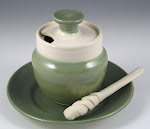Once upon a time in the life of a potter there came an opportunity knocking.
“We are new head counselors in a special summer place for kids,” said two nice people whom the potter knew,“ and there is an empty room in this special place where it looks like pottery was made a long time ago. Would you come and do your thing there with the special children?”
The potter had an inkling that this really was an opportunity, but she was not sure. Many of the special children were sick. She thought their being sick might make her too sad. “I will come look at it,” she said.
The room was small but the potter liked it. She decided to try to teach the special children pottery there.
But the potter had never taught children before, whether well or sick. ‘I will take this job for this one year,’ she thought, ‘and I will see if I can really do it right.' The potter discovered that the special kids were children like her own children. They danced and sang, they got silly or tired or cranky or creative like her own children. Some of them were not feeling too well and sat down a lot. Some were very sick indeed. This is what made them “special” at the camp. But the potter discovered something.
The children had fun with the clay! They had fun with the potter, and she with them! They made skulls and plaques and hearts. They made pencil jars and ceramic fruit, and something that two of them called “devil chickens.” They made things from their hearts and imaginations. The potter loved it all. She learned to work fast and teach clearly. She discovered that the hard job was a pleasure because she loved working with the kids.
Her second summer, she made a tag out of clay to sew onto her baseball cap. It read “Mrs. Pottery Head.”
The children knew her as “Mrs. Pots” or “Mrs. Pot Lady," or by the name on the tag on her hat. The potter considered it a badge of honor to be known this way. Some knew her as Mimi since, coincidentally, she had the same name as the author of this story.
Each year certain of the children came back to the special summer place. The potter got to know these children pretty well and became especially fond of them. After the summer, the special summer place lived all year in the potter’s heart.
After eight summers, for reasons which were not her fault and which are too silly to put into this story, the potter could no longer work in the special summer place.
What could she do about her sense of loss that she could no longer work with the children? The potter decided to go to school. There in a room with a very fine sculpture teacher, the potter began moving clay around in a new way. After months of practice, and time spent looking at the many photographs she had taken of the children and events over the years at the special summer place, the potter began a sculpture that would make her feel better.
One day in the special summer place, she had taken a picture of two boys sitting on chairs in the grass, playing a djembe (which is a fancy name for an African drum) between them. One boy was a counselor, age 21, the other boy a camper, age 20, who had lost his leg to a bad sickness. The boy with one leg was well now. He was the owner of the drum. He tended to have an outstanding joy in life, which at that moment propelled his hands over the instrument. He was teaching his counselor to drum.
Now the potter worked and worked to sculpt the moment captured in the photo. She tried very hard to show the healing that comes about from making music for the world around us. She realized right away that it was the same joy that comes from teaching pottery to children. She knew it was the same joy all people can find inside themselves when they reach down inside and try.
The potter worked for 50 hours over the course of many weeks until the sculpture was finished. Carving and adding and subtracting the clay became a dance of motion for her. She was completely absorbed in the moment of drum play, for all those many hours. When she was done at last, she had a permanent reminder of the strength and healing power of creative effort- the injured boy's, and her own. She felt much, much better.
She named the sculpture Expressive Healing.
(...and the view from the other side:)
Subscribe to:
Post Comments (Atom)




I have always loved this sculpture.
ReplyDeleteAnd have always hated tiny ceramic fruit.
After all the passage of time, I'm not nearly as bitter and angry about the whole thing as I used to be, but there's still some sting there. I could work for them again now, as my marriage has rendered me more halachically assur, but more socially acceptable (I've never quite worked that one out). But I think it's been poisoned for me, and I can't really ever go back there again. I'd always hoped that the passage of time would allow me to fully forgive, but it hasn't, not yet. I think the sculpture let you purge some of that, which is wonderful.
It was a time of rich rewards (none of them monetary). The rest is put away. Remember the fun and the poignant moments. They are still there, deep down, shining under the stupid political/gender role issue garbage.
ReplyDeleteStilting those tiny glazed ceramic grapes individually on the kiln shelves was a real pain, wasn't it? Till we learned to outlaw them: attached clusters or nothing! It was marvelous working with you there.